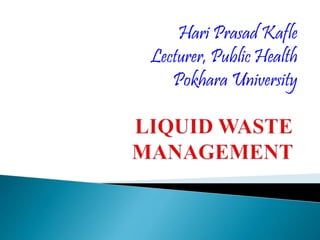
Liquid waste management
- 1. Hari Prasad Kafle Lecturer, Public Health Pokhara University
- 2. The four things that have spoiled your life are: “I” and “mine”, “You” and “Yours”. Forget them.
- 3. Sewage is waste water from a community, containing solid and liquid excreta, derived from houses, street and yard washing, factories and industries. The term sullage is applied to waste water which does not contain excreta, e.g. waste water from kitchen and bathrooms.
- 4. a. Creation of nuisance, unsightness and unpleasant ouder. b.Breeding of flies and mosquitoes. c. Pollution of soil and water supplies. d.Contamination of food. e. Increase in the incidence of disease, especially enteric and helminthic disease.
- 6. Water: 99.9% 0rganic and inorganic solid: 0.1% One gram faeces may contain about 1000 million E, coli, 10-100 million faecal streptococci, and 1-10 million spores of Cl. Perfringens.
- 7. To stabilize the organic matters so that it can be disposed off safely and to convert the sewage water into an effluent of an acceptable standard of purity which can be disposed of in to land, rivers or sea. A standard test which is an indicator of the organic content of the sewage is biochemical oxygen demand(BOD).
- 8. BOD is defined as the amount of oxygen absorbed by a sample of sewage during specified period, generally five days, at a specific temperature, generally by living organism. BOD value range from 1mg/liter for natural water to 300 mg/liter for untreated sewage.
- 9. Aerobic process: in presence of oxygen organic matter is broken down into CO2, water, ammonia, nitrites, nitrates and sulfates by action of bacterial action including fungi and protozoa. Anaerobic process: anaerobic bacteria decompose organic waste into methane, ammonia, CO2, and H2.
- 10. Landfill/mine reclamation Secondary Treatment Air Raw sewage Grit Chamber Sludge Digester Activated Sludge Sludge drying beds Sedimentation Tank Aeration Tank Final Sedimentation Tank Screens Rivers, lakes, oceans, etc. Primary Treatment Disinfection
- 14. Primary treatment ◦ solids are separated Secondary treatment ◦ dissolved biological matter is converted into a solid mass by using water-borne bacteria ◦ 95% of the suspended molecules should be removed Tertiary treatment ◦ biological solids are neutralized then disposed, and treated water may be disinfected chemically or physically
- 15. Mechanical treatment ◦ Influx (Influent) ◦ Removal of large objects ◦ Removal of sand and grit ◦ Primary Sedimentation Biological treatment ◦ Trickling bed filter ◦ Activated sludge Chemical treatment ◦ Disinfection
- 16. Screening Great chamber Primary Sedimentation
- 17. Sewage first passed through metal screen to remove large floating objectives such as pieces of woods, rags, plastics paces, masses of garbage and dead animals. The screen consist of vertical steel bars usually set 5 cm apart.
- 19. After screen sewage is then passed through a long narrow chamber called as grit chamber or detritus chamber. The chamber is about 10-20 meter and velocity of sewage flow is about 1 foot per second taking a detention period of 0.5-1 minute.
- 20. The grit chamber allows to settle down heavier solids such as sand and gravel while permitting the organic matter passing through. The grit collected at the bottom of camber is removed periodically or continuously.
- 22. After passing through, sewage is then admitted to a huge rectangular tank called as Primary sedimentation tank. Sewage is made to flow very slowly across the tank at a velocity of 1-2 feet/minute and retained 6-8 hours in tank.
- 23. Nearly 50-70% organic solids settled down due to gravity. The sludge is removed mechanically operated devices and subjected to sludge dryer. Due to biological action certain treatment takes place. Scum at the uppermost layer should be removed periodically.
- 26. The effluent from the primary sedimentation tank still contains a proportion of organic matters in solution and numerous living organism. It has high oxygen demand and subjected to further treatment ‘aerobic oxidation’ by one of the following methods: Trickling bed filter method Activated sludge process
- 27. Spread wastewater over microorganism. Made of coke (carbonized coal), limestone chips or specially fabricated plastic media. Optimize their thickness by insect or worm grazing.
- 31. To remove suspended solids, nitrogen, and phosphate About 90 % removal of BOD5 and SS About 20 % removal of phosphate Variable removal levels of viruses, 20-80 % removal of bacteria and >90 % removal of protozoa.
- 32. Subjected to aeration chamber for aeration for 6-8 hours. The aeration is accomplished by either mechanically agitation or by forcing compressed air continuously from the bottom of aeration tank.
- 33. The organic matter of the sewage get oxidized into Co2, nitrates and water with the help of aerobic bacteria. Best suited for mega and metro cities because it occupies small space the trickling filter.
- 35. The oxidized sewage from the trickling filter or aeration chamber is led into the secondary sedimentation tank for 2-3 hours. The ‘aerated sludge' is pumped back into the aeration tank for activated sludge process and finally into the sludge digestion tank.
- 36. To inactivate pathogens in wastewater Several choices ◦ Free chlorine and combined chlorine ◦ UV ◦ Ozone ◦ Chlorine dioxide
- 37. Use for Irrigation Disposal in river, sea, lakes, ponds etc.
- 38. 3-4 weeks complete digestion takes place and it is carried out in sludge drying bed. Digested sludge is used as organic fertilizer for agricultural purpose.
